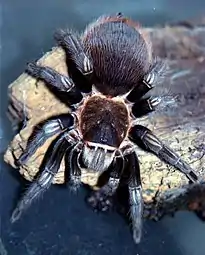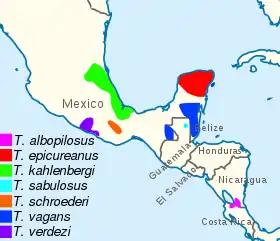Tliltocatl
Tliltocatl is a genus of spiders in the tarantula family Theraphosidae. It was split off from Brachypelma in 2020.[1][2] Species in Tliltocatl are found predominantly in Mexico, with some species native to Central America. They are large burrowing tarantulas, without the striking red leg markings of Brachypelma species.
| Tliltocatl | |
|---|---|
.jpg.webp) | |
| Tliltocatl vagans | |
| Scientific classification | |
| Kingdom: | Animalia |
| Phylum: | Arthropoda |
| Subphylum: | Chelicerata |
| Class: | Arachnida |
| Order: | Araneae |
| Infraorder: | Mygalomorphae |
| Family: | Theraphosidae |
| Genus: | Tliltocatl Mendoza & Francke, 2020[1] |
| Type species | |
| Eurypelma vagans Ausserer, 1875 | |
| Species | |
Description
Species of Tliltocatl are relatively large. A female T. vagans, for example, may have a total body length of more than 50 mm (2.0 in) and a maximum leg length of over 55 mm (2.2 in).[3] The carapace is about as long as wide, the sternum being longer than wide. The first leg is the longest. All four legs have undivided scopuli on the tarsus. Stridulating hairs are present on the retrolateral face of the trochanter of the pedipalp and on the prolateral face of the trochanter and femur of the first leg. Sexually mature males have two tibial apophyses, the retrolateral one being slightly curved at the end.[2]
The genus Tliltocatl shares many features with Brachypelma. For example, both genera have stridulating hairs in the same locations. Both have type I and type III urticating hairs on the rear of their abdomens, with type I surrounding type III. Their male palpal bulbs are similar, being spoon-shaped at the end. Females have a single fused spermatheca with an absent or weakly developed baseplate. Tliltocatl species differ from Brachypelma in coloration. Their legs are blackish, without red rings. Their carapaces are mostly dark, without detailed red markings, and they have long red or yellowish hairs on their abdomens. The patellae of the palps and legs have spines. The detailed shapes of the genitalia also differ between the two genera.[2]
- Comparison of typical Tliltocatl and Brachypelma species
 Tliltocatl cf. sabulosum
Tliltocatl cf. sabulosum Brachypelma boehmei
Brachypelma boehmei
Taxonomy
The genus Tliltocatl was erected by Mendoza and Francke in 2020, following a number of molecular phylogenetic studies showing that, as previously circumscribed, Brachypelma was not monophyletic, consisting of two distinct clades.[2] A study in 2017 had identified the "red leg" and "red rump" clades, treating the "red leg" group as Brachypelma s.s..[4] The previously identified "red rump" clade was then separated as the genus Tliltocatl.[2] The genus name is derived from two Nahuatl words, tlil meaning 'black' and tocatl meaning 'spider', and is masculine.[2]
Phylogeny
A maximum likelihood cladogram based on a mitochondrial gene showed Tliltocatl well separated from Brachypelma, with the internal relationships of Tliltocatl as shown below. The position of T. verdezi and T. kahlenbergi could not be resolved, and the clade formed by T. vagans, T. sabulosus and T. albopilosus had weak internal support.[2] The distribution of the species shows some relationship with the cladogram, with the three western Mexican species, T. schroederi, T. kahlenbergi and T. verdezi, separated from the remaining species from eastern Mexico and Central America.
| Tliltocatl |
| |||||||||||||||||||||||||||||||||
Species
As of March 2020, the World Spider Catalog accepted the species listed below, all previously placed in Brachypelma.[1]
- Tliltocatl albopilosus (Valerio, 1980) – Costa Rica
- Tliltocatl epicureanus (Chamberlin, 1925) – Mexico
- Tliltocatl kahlenbergi (Rudloff, 2008) – Mexico
- Tliltocatl sabulosus (F. O. Pickard-Cambridge, 1897) – Guatemala
- Tliltocatl schroederi (Rudloff, 2003) – Mexico
- Tliltocatl vagans (Ausserer, 1875) (type species) – Mexico, Guatemala, Belize
- Tliltocatl verdezi (Schmidt, 2003) – Mexico
Three further species names are regarded as nomina dubia (doubtful names):
- Tliltocatl alvarezi (Estrada-Alvarez, Guadarrama & Martínez, 2013) – Mexico
- Tliltocatl andrewi (Schmidt, 1992) – origin unknown
- Tliltocatl aureoceps (Chamberlin, 1917) – US or Mexico
Distribution and habitat

Tliltocatl species are native to Mexico and Central America. The precise distribution of some species is uncertain, partly because they were described from pet trade specimens. For example, T. kahlenbergi was described from specimens that had originally been sent to Germany for this purpose from Veracruz in Mexico.[5] A map of confirmed specimens produced by Mendoza and Francke (2020) shows Mexico, Guatemala, Belize, Nicaragua and Costa Rica,[2] a distribution largely supported by the World Spider Catalog.[1] In the text, Mendoza and Francke add Honduras and El Salvador. Species occur both in the west (the Pacific coast) and the east (the Atlantic Coast and the Gulf of Mexico). They are found in a variety of habitats, including deciduous forest, evergreen rain forest and grasslands. They live in burrows, which may be under objects such as rocks, logs and tree roots. Some species dig burrows in farmlands and gardens.[2]
Conservation
Habitat destruction and collection for the pet trade led to the genus Brachypelma, then including Tliltocatl, being among the few arthropods protected under international Convention on International Trade of Endangered Species rules, beginning with B. smithi.[6] Large numbers of Mexican tarantulas caught in the wild continue to be smuggled out of Mexico. The threat to the less colourful species in the genus Tliltocatl is considered less severe.[2][4]
References
- "Gen. Tliltocatl Mendoza & Francke, 2020", World Spider Catalog, Natural History Museum Bern, retrieved 2020-03-01
- Mendoza, Jorge & Francke, Oscar (2020), "Systematic revision of Mexican threatened tarantulas Brachypelma (Araneae: Theraphosidae: Theraphosinae), with a description of a new genus, and implications on the conservation", Zoological Journal of the Linnean Society, 188 (1): 82–147, doi:10.1093/zoolinnean/zlz046
- Smith, Andrew M. (1994), Tarantula Spiders : Tarantulas of the USA and Mexico, London: Fitzgerald Publishing, ISBN 978-0-9510939-9-3, p. 367 of the complete work
- Turner, Steven P.; Longhorn, Stuart J.; Hamilton, Chris A.; Gabriel, Ray; Pérez-Miles, Fernando & Vogler, Alfried P. (2017), "Re-evaluating conservation priorities of New World tarantulas (Araneae: Theraphosidae) in a molecular framework indicates non-monophyly of the genera, Aphonopelma and Brachypelma", Systematics and Biodiversity, 16 (1): 89–107, doi:10.1080/14772000.2017.1346719
- Rudloff, J.-P. (2008), "Eine neue Brachypelma-Art aus Mexiko (Araneae: Mygalomorphae: Theraphosidae: Theraphosinae)", Arthropoda (in German), 16 (2): 26–30
- "Brachypelma smithi (F. O. Pickard-Cambridge, 1897): Documents", Species+, UNEP-WCMC & CITES Secretariat, retrieved 2020-03-06
